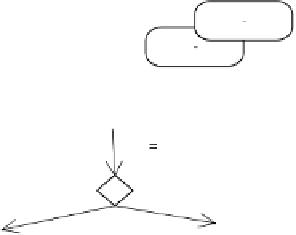Information Technology Reference
In-Depth Information
naïve state, prior to the antigen encounter, to then reach an “active” state once the
antigen is encountered. In this active state, the cell enters in a process proliferation
successively producing new clones. Following a certain number of duplication, part of
the resulting T or B clones turn into an effector state where they can either produce
antibodies (in the case of B cells), kill infected cells (in the case of cytotoxic T cells),
suppress or regulate the action of other cells (in the case of helper T cells). This trans-
formation process is at the origin of the immune response to the infecting pathogen.
The remaining part of the T or B clones is transformed into memory cells. While
immune memory is still a topic of vivid investigation, B and T cells in this new state
seem to handle the memory role mainly because their death rate becomes much
smaller than their ancestor. Additionally, back to the naïve state and ready in their
turn to be activated by an antigen encounter, they appear to be faster to switch to the
effector state and even to act more intensively. This whole process can be simply
illustrated by the following state-transition UML diagram.
Fig. 3.
A basic UML state-transition diagram illustrating the minimal cell transitions at the
basis of the immune response and the memorization of this response
The two black disks above and below represent the birth and the death of the con-
sidered cell. A state transition diagram theoretically only concerns one unique object
and its succession of states while, in this example, as a result of the cloning process,
the active, the memory and the effector cells need to be different objects. Still, it is
interesting to formally capture in one unique diagram the idea that in order to become
memory or effector, a cell has to divide a certain number of times (in this state dia-
gram and in our simulation explained below a clone labeled N disappears to give birth
to two clones labeled N-1 and so forth until N=0), only the resulting clones being able
to assume this new role. Another principle illustrated by the diagram is the probabilis-
tic transformation of a clone into either a memory or an effector cell. In certain simu-
lations [21], the switch to the memory state takes place before the effector state and as
an alternative to it, while in others [6, 7] only a subset of effector cells will be
changed into memory cells. There is another problem with this state transition dia-
gram, still resulting from the cloning process. Although represented in the diagram by
a transition of the memory cell back to the naïve state and although a memory cell



























